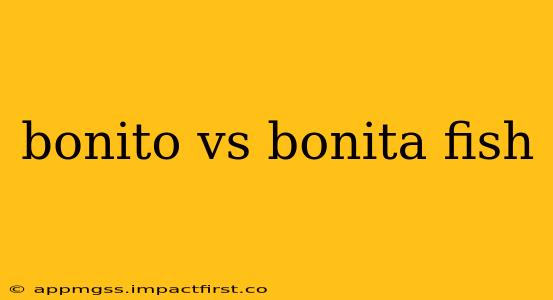The terms "bonito" and "bonita" are often used interchangeably, leading to confusion among fish enthusiasts and consumers. While both refer to a group of fast-swimming, predatory fish belonging to the Scombridae family (which also includes tuna and mackerel), there are key distinctions. This article will clarify the differences between bonito and bonita, exploring their characteristics, culinary uses, and common misconceptions.
What is a Bonito?
The term "bonito" is a more general term encompassing several species of mackerel-like fish. These fish are characterized by their streamlined bodies, forked tails, and vibrant coloration, often featuring metallic blue or green hues on their backs and silvery sides. Bonitos are found in tropical and temperate waters worldwide. Different species exhibit variations in size, ranging from relatively small to moderately large. They are known for their strong, fast swimming abilities, essential for their predatory lifestyle.
Some well-known bonito species include:
- Atlantic bonito (Sarda sarda): Found in the Atlantic Ocean.
- Pacific bonito (Sarda chiliensis): Found in the Pacific Ocean.
- Striped bonito (Sarda orientalis): Found in the Indian and Pacific Oceans.
These species share similar characteristics but may display subtle differences in their markings and size.
What is a Bonita?
"Bonita" is often used as a colloquial term, often referring specifically to the Pacific bonito (Sarda chiliensis). In some regions, and especially in the culinary world, "bonita" might be used as a synonym for "bonito" in general, creating the overlap and ambiguity. However, technically, all bonitas are bonitos, but not all bonitos are necessarily called bonitas. The usage is geographically and culturally influenced.
Are Bonito and Bonita the Same Fish?
The short answer is: mostly, yes, but with nuances. The term "bonita" is often used interchangeably with "bonito," particularly when referring to Pacific bonito. However, "bonito" encompasses a broader range of species within the Scombridae family. Think of "bonito" as the umbrella term and "bonita" as referring to a specific type under that umbrella, primarily the Pacific bonito.
What are the Culinary Differences?
The culinary applications of bonito and bonita are largely the same, as they are closely related species. Their meat is generally firm and has a slightly oily texture, lending itself well to various cooking methods:
- Sashimi/Sushi: Thinly sliced and served raw.
- Grilling: Excellent for grilling due to their firm flesh.
- Broiling: Similar to grilling, achieving a flavorful, slightly charred exterior.
- Ceviche: Used in this traditional Latin American dish due to its ability to cure well in citrus juices.
How Can I Tell the Difference?
Visually differentiating between specific bonito species, including the Pacific bonito (often called bonita), requires expertise. Subtle variations in coloration and markings are often not readily apparent to the casual observer. Unless you're working with a fish expert or have a reliable source providing specific species identification, it's generally acceptable to consider them culinary equivalents.
Frequently Asked Questions (FAQs) – Addressing potential "People Also Ask" queries
Is bonito fish good for you?
Bonito, like other oily fish, is a good source of protein and omega-3 fatty acids, beneficial for heart health. However, mercury content can vary depending on the species and its environment; moderation is key.
What does bonito taste like?
Bonito possesses a rich, slightly oily flavor, often described as a blend of tuna and mackerel. Its taste can also vary slightly depending on the species and preparation method.
What is the best way to cook bonito?
Grilling and broiling are popular methods for enhancing bonito's flavor and texture. Searing it quickly can create a flavorful crust while keeping the interior moist.
Is bonito a sustainable fish?
Sustainability varies by species and fishing practices. Check with reputable seafood guides or certifications before purchasing to ensure you're choosing sustainably sourced bonito.
Where can I buy bonito?
Bonito can be found at fish markets, specialty seafood stores, and some supermarkets, especially in coastal regions or areas with a strong seafood culture. Availability varies depending on the season and location.
In conclusion, while "bonito" and "bonita" are often used interchangeably, understanding the subtle differences in their usage can enhance your appreciation for these delicious and versatile fish. Remember to prioritize sustainable sourcing and enjoy the unique flavors they bring to the table.
